Home Decor
Top Designers Reveal Why Indonesian Textiles Are a Must for Modern Homes
Uncover the secrets behind Indonesian textiles and why top designers believe they are essential for modern homes—discover the transformative power they hold.

Indonesian textiles add unmatched character to modern homes while showcasing a rich cultural heritage. Designers love the vibrant colors and intricate patterns that not only beautify your space but also serve as conversation starters. Sustainable practices are essential too, as many artisans use organic materials and traditional methods. This commitment to craftsmanship and eco-friendliness aligns perfectly with today's design trends. Plus, blending these textiles with contemporary decor creates a unique aesthetic that's both inviting and meaningful. Discover how you can incorporate these stunning pieces and enhance your home's ambiance with tales of heritage and artistry.
Key Takeaways
- Indonesian textiles, like batik, combine rich cultural heritage with modern aesthetics, making them ideal for contemporary home decor.
- The vibrant colors and intricate patterns of Indonesian textiles enhance visual appeal and create unique focal points in any space.
- Sustainable practices in textile production align with eco-conscious consumer trends, ensuring environmentally friendly choices without compromising style.
- Incorporating artisan-made textiles supports local craftsmanship and fosters community pride, enriching the narrative of home decor.
- The versatility of Indonesian textiles allows for creative adaptations, seamlessly blending traditional elements with modern designs for a balanced aesthetic.
Historical Significance of Indonesian Textiles

Indonesian textiles, especially batik, hold a rich historical significance that dates back over a millennium. You'll find that batik was once integral to cultural ceremonies and royal courts, symbolizing the deep-rooted traditions of Indonesian society.
This form of Indonesian traditional textile art involves applying hot wax to fabric, creating intricate designs that often carry profound symbolic meanings linked to heritage. Additionally, the art of crafting traditional artistry is reflected in the vibrant colors and unique motifs found in various Indonesian decor masks, showcasing the country's diverse cultural expressions.
In 2009, UNESCO recognized Indonesian batik as an Intangible Cultural Heritage of Humanity, highlighting its global cultural importance. This acknowledgment not only reflects the artistry involved but also showcases the pivotal role batik plays in Indonesian identity.
As you explore the evolution of batik, you'll see how it changed from ceremonial wear to a staple in modern fashion. This adaptability makes it relevant in contemporary lifestyles while still preserving the traditional craftsmanship that defines its essence.
Annual festivals and exhibitions, like "Batik Kita: Dressing in Port Cities," celebrate this rich history, promoting both the heritage and modern adaptations of Indonesian textiles.
Engaging with batik is like connecting with a vibrant narrative that spans centuries, making it a fascinating choice for your modern home.
Modern Interpretations of Batik
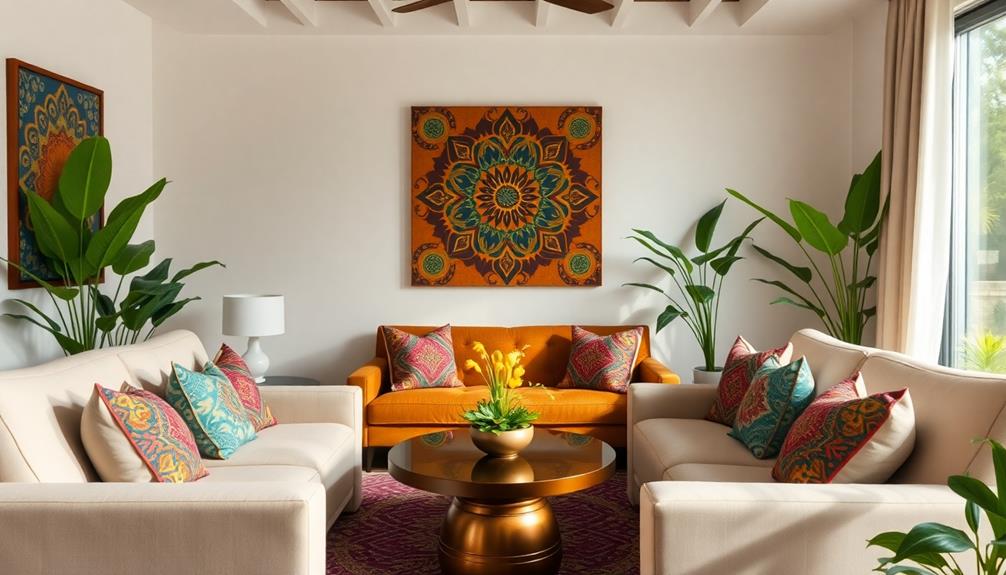
When you explore modern interpretations of batik, you'll notice how contemporary designers merge traditional techniques with fresh, vibrant aesthetics.
This fusion not only revitalizes batik for today's fashion and home decor but also highlights sustainable practices by using organic materials.
Furthermore, these designs often draw inspiration from rich cultural elements, like the Face Indonesian Decor Mask, which adds a unique touch to modern spaces.
As you discover these innovative designs, you'll see how they honor cultural heritage while appealing to a new generation.
Contemporary Batik Designs
Many modern designers are reimagining batik, blending its rich heritage with contemporary aesthetics. Designers like Tan Sheau Yun creatively incorporate traditional elements into chic pieces, such as batik cheongsams, which reflect a fusion of cultures. This evolution has transformed batik from a ceremonial textile into a staple in everyday fashion, showcasing its adaptability to current trends.
The use of vibrant colors and intricate patterns in contemporary batik also mirrors the traditional Indonesian style home decor, enhancing its appeal in modern interiors.
Young designers are essential in revitalizing batik, merging traditional craftsmanship with innovative designs that resonate with younger audiences. Their fresh interpretations keep the essence of batik alive while making it relevant in today's fashion scene.
Plus, the focus on sustainable practices in contemporary batik production emphasizes the importance of responsible fashion. Many artisans are using organic dyes and minimal electricity, ensuring that each piece not only looks good but is also environmentally friendly.
Collaborative initiatives, like those involving the Nanyang Academy of Fine Arts and the Asian Civilisations Museum, further enrich the landscape of contemporary batik. These efforts encourage broader appreciation and understanding of this cultural art form, making it a must-have in modern homes.
Embracing contemporary batik means celebrating both tradition and innovation in your wardrobe.
Cultural Fusion in Fashion
Cultural fusion in fashion has never been more vibrant, with designers creatively blending batik with contemporary styles to produce unique pieces that resonate with diverse audiences. This reimagining of batik celebrates its rich heritage while making it relevant for today's fashion scene.
Modern interpretations, like batik cheongsams, showcase how traditional textiles can be transformed to reflect contemporary aesthetics. The incorporation of Indonesian decorative pillows into home décor also highlights the versatility of batik, allowing it to enhance living spaces with vibrant colors and intricate patterns.
Here are some key elements driving this cultural fusion in batik fashion:
- Innovative Designs: Young designers are experimenting with bold color combinations and fresh silhouettes.
- Cultural Identity: Exhibitions like "Batik Kita" emphasize batik's role in expressing evolving identities in multi-ethnic societies.
- Market Appeal: By appealing to younger generations, batik's market potential is markedly enhanced.
- Sustainability: Designers are prioritizing organic dyes and artisan techniques in batik production to meet the demand for responsible fashion.
- Global Recognition: UNESCO's recognition of batik as an Intangible Cultural Heritage of Humanity has boosted its appreciation and cultural significance.
As you explore modern batik pieces, you'll see how this cultural fusion not only honors tradition but also shapes the future of fashion.
Sustainable Textile Innovations
Sustainable Textile Innovations (Modern Interpretations of Batik)
As designers embrace sustainable textile innovations, modern interpretations of batik are emerging that not only honor traditional practices but also cater to eco-conscious consumers. These contemporary batik pieces often draw inspiration from traditional Indonesian housing, showcasing the rich cultural heritage embedded in their designs.
You'll find that these contemporary batik pieces incorporate eco-friendly materials and sustainable practices, preserving the artistry while appealing to modern sensibilities. Designers are pushing boundaries with innovative designs and vibrant color combinations, enhancing the visual appeal of batik textiles for your home decor.
The adaptability of batik in contemporary fashion reflects a growing interest in responsible fashion, emphasizing artisan-made, non-mass-produced pieces. Young designers play a significant role in reimagining batik, blending traditional techniques with modern aesthetics to create unique textiles that resonate with you and today's consumers.
Moreover, the use of organic dyes and minimal electricity in batik production aligns perfectly with sustainability goals. This showcases the art form's commitment to environmental consciousness, allowing you to make thoughtful choices in your decor.
The Role of Sustainable Practices
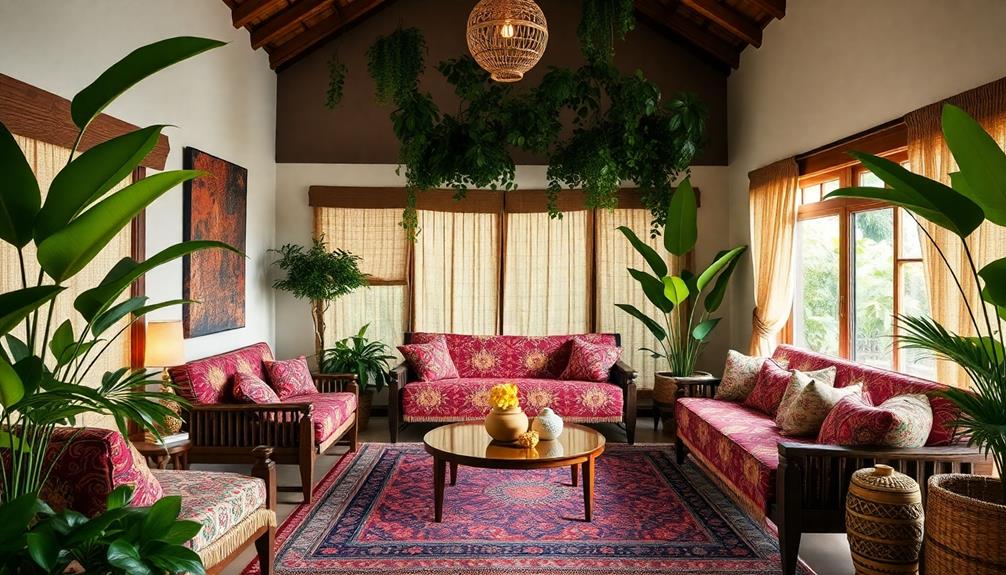
Sustainable practices in Indonesian textile production play a crucial role in preserving not just the environment but also the rich heritage of craftsmanship.
By focusing on artisan-made batik and organic dyes, these practices minimize environmental impact while honoring traditional techniques. The importance of Indonesian decor masks can also be seen in the way they reflect cultural heritage, just as textiles do.
Here's why incorporating sustainable textiles into your home is fundamental:
- Heritage Preservation: Artisan techniques guarantee the continuity of cultural identity and craftsmanship.
- Eco-Friendly Materials: Using natural fibers like cotton and silk aligns with modern design and eco-conscious choices.
- Responsible Consumption: Brands like Nost promote custom-made garments over fast fashion, encouraging thoughtful purchasing decisions.
- Minimal Environmental Footprint: Local resource use and low electricity consumption reduce the overall ecological impact of textile production.
- Skill Development: The intricate process of creating batik stamps nurtures skilled artisans and guarantees the art form's survival for future generations.
Aesthetic Appeal in Interior Design
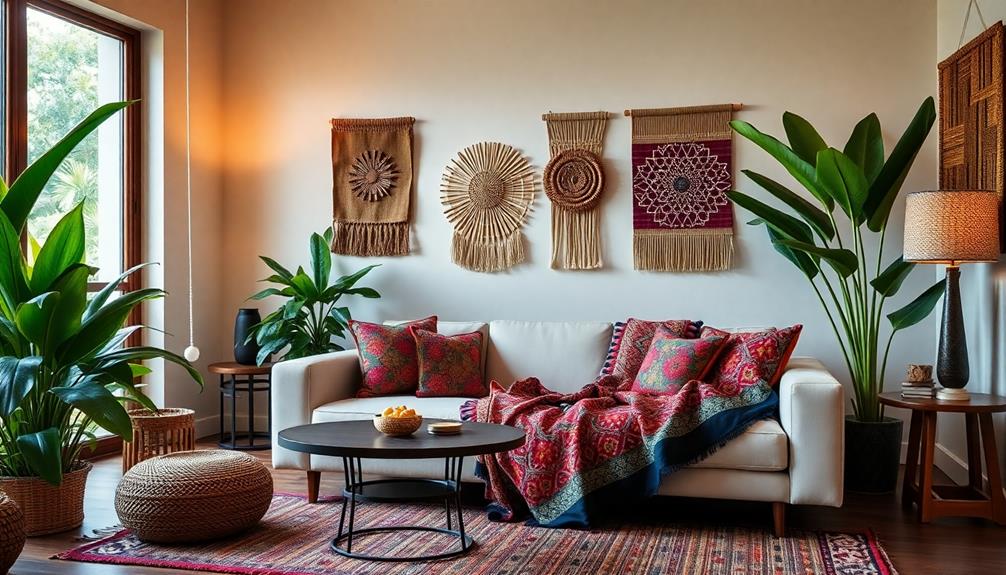
When you incorporate Indonesian textiles into your home, you're not just adding beauty; you're inviting unique cultural narratives into your space.
The textural diversity and warmth of materials like batik and ikat create a cozy atmosphere that resonates with both tradition and modernity. This blend enhances your interior design, making your environment feel richer and more inviting.
Additionally, these textiles can complement the emphasis on natural materials in Balinese design characteristics, creating a harmonious balance between culture and aesthetics.
Unique Cultural Narratives
The allure of Indonesian textiles lies not just in their vibrant colors and intricate patterns, but in the rich cultural narratives they embody. When you incorporate traditional textiles like batik and ikat into your home, you're not just adding beauty; you're inviting a piece of history and heritage into your space.
These textiles resonate with deeper meanings, offering stories that can transform your interior design, much like the embrace of tropical contemporary architecture that harmonizes modern living with natural surroundings.
- Cultural Heritage: Each pattern tells a story, connecting you to Indonesia's diverse roots.
- Artisan Craftsmanship: Handwoven pieces celebrate local artisans, promoting sustainable practices.
- Ambiance Influence: Earthy tones and vibrant colors can enhance tranquility or energy in your home.
- Conversation Starters: Unique designs spark discussions about the cultural significance behind them.
- Modern Blend: The revival of these textiles showcases a beautiful mix of traditional artistry with contemporary trends.
Textural Diversity and Warmth
How can you elevate your home's aesthetic with the rich textural diversity of Indonesian textiles? By incorporating pieces like batik and ikat, you'll instantly enhance your space's warmth and inviting atmosphere.
These textiles aren't just visually appealing; they bring a layer of traditional Indonesian aesthetics that resonates deeply with cultural significance. Additionally, the integration of sustainable practices in design guarantees that your choices contribute positively to both the environment and the local community.
Opting for natural materials in these textiles aligns your design choices with eco-friendly trends, making your decor sustainable. The earthy tones and vibrant colors found in Indonesian textiles create visual interest while promoting a sense of tranquility and connection to heritage.
It's a perfect way to celebrate artistry and craftsmanship in your home. When you integrate local handicrafts, like handwoven textiles, you add character and uniqueness to your interiors.
This fusion of traditional Indonesian textiles with contemporary design fosters a harmonious blend of cultural heritage and modern aesthetics. Ultimately, these textiles enrich your home's ambiance, making it not just a living space but a canvas that tells a story.
Embrace the textural diversity of Indonesian textiles, and watch your home transform into a warm, inviting sanctuary.
Cultural Connection Through Textiles

Indonesian textiles, like batik and ikat, connect you to a vibrant cultural heritage that resonates deeply with identity and craftsmanship. Incorporating these textiles can also enhance your event decor, as seen in various Indonesian wedding decor ideas, creating a unique atmosphere that reflects traditional artistry.
Each piece serves not just as decor but as a storytelling medium, reflecting the rich history and diverse communities of Indonesia. By incorporating these traditional textiles into your modern home, you create a unique blend of past and present that speaks volumes.
Here are a few reasons why these textiles are essential:
- Cultural Significance: Each design often tells a story, connecting you to the traditions of the artisans who create them.
- Artisan Support: Purchasing these textiles helps sustain local craftsmanship and promotes fair trade practices.
- Sustainable Practices: Many artisans use eco-friendly methods, aligning with your values for a sustainable lifestyle.
- Aesthetic Appeal: The intricate patterns and vibrant colors enhance the visual appeal of any space.
- Emotional Resonance: These textiles can evoke memories and feelings, creating a warm, inviting atmosphere in your home.
Innovations by Emerging Designers
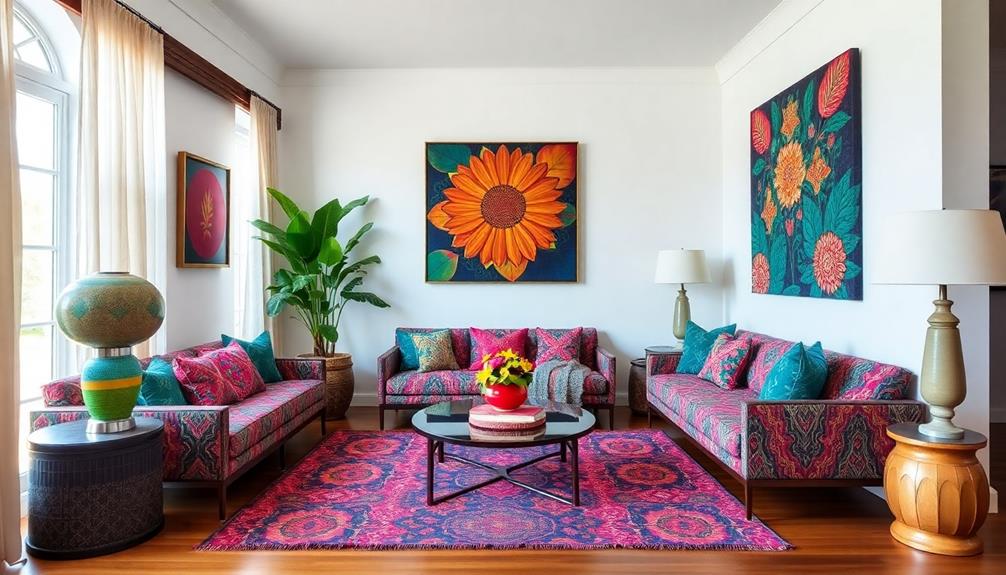
Emerging designers are breathing new life into traditional Indonesian textiles by weaving them into modern home decor. These innovative creators are taking beloved fabrics like batik and ikat and reimagining them for today's aesthetic, blending cultural heritage with contemporary style.
Their collections often emphasize eco-friendly materials and sustainable practices, showcasing a commitment to both the environment and the rich history of heritage textiles.
You'll find that these designers are experimenting with unexpected color combinations and patterns inspired by nature, resulting in unique pieces that resonate with modern consumers.
Collaborations with local artisans play an essential role, as they preserve traditional crafting techniques while introducing these textiles to a broader audience. This fusion not only enhances the aesthetic appeal of your home but also fosters a deeper appreciation for the cultural narratives and craftsmanship behind each piece.
As you explore these innovations, you'll discover how traditional Indonesian textiles can add a fresh perspective to your decor, making your space not just stylish but also rich in story and significance.
Embracing these designs allows you to celebrate both art and culture in your modern home.
Incorporating Textiles in Home Decor

Incorporating textiles into your home decor can transform your space, adding a unique character that celebrates rich artistry and cultural significance.
Traditional Indonesian fabrics like batik and ikat not only enhance the beauty of your interiors but also tell a story of heritage and craftsmanship.
Here are some ways to effectively integrate these textiles into your home:
- Accent Pillows: Use vibrant batik-covered cushions on sofas to inject color and comfort.
- Table Runners: Place an ikat table runner on your dining table for a stunning focal point during meals.
- Wall Hangings: Hang large pieces of traditional fabric as art to showcase intricate patterns and designs.
- Throw Blankets: Drape a handwoven throw over a chair for warmth and a touch of elegance.
- Curtains: Choose lightweight Indonesian fabrics for curtains that filter light beautifully while adding texture.
Balancing Tradition and Modernity
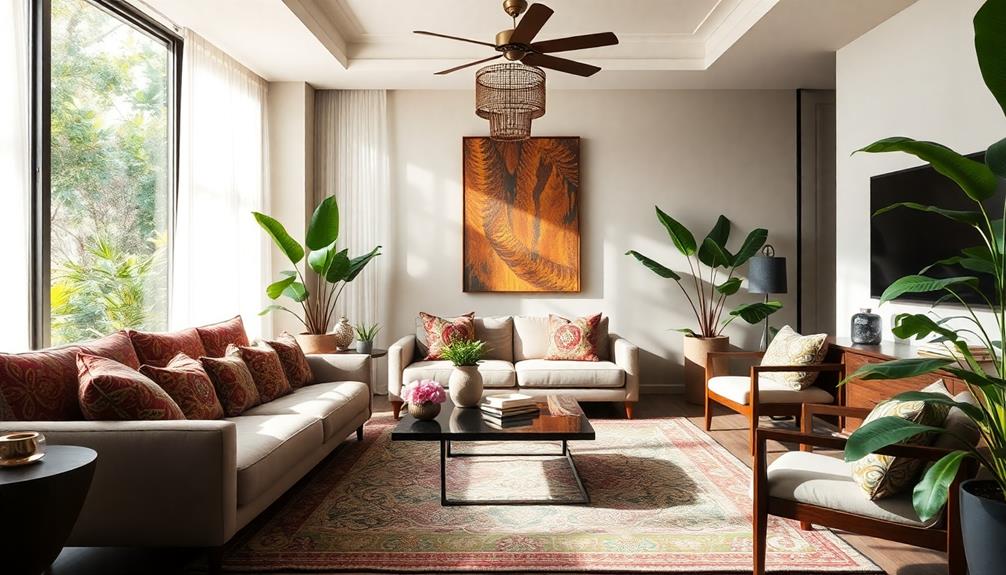
Bringing traditional Indonesian textiles into your home decor doesn't just celebrate artistry; it also sparks a fascinating conversation between history and modern design. By incorporating pieces like batik, you can embrace the rich cultural heritage of Indonesia while making it relevant to contemporary aesthetics.
These textiles embody Indonesian identity and showcase how traditional patterns can blend seamlessly with modern interior styles. Designers are reinterpreting these textiles, allowing them to thrive in today's homes without losing their significance.
You'll find that the vibrant colors and intricate designs enhance your space, creating a unique atmosphere that reflects both heritage and modern taste. This balance is vital, as it honors the artistry of local artisans while promoting sustainable practices.
Collaborations between contemporary designers and local artisans play a significant role in this process. They guarantee that the craftsmanship behind Indonesian textiles isn't only preserved but also innovated, making these fabrics a staple in modern decor.
Future Trends in Textile Use

As we look ahead, the use of traditional Indonesian textiles in home decor is evolving, reflecting a blend of cultural appreciation and modern design sensibilities.
Designers are now producing creations that merge the beauty of batik and ikat with contemporary aesthetics, making these textiles more relevant than ever.
Here are some future trends to watch:
- Cultural Fusion: Expect to see more combinations of Indonesian textiles with other global styles, creating unique, eclectic looks.
- Sustainable Choices: The demand for eco-friendly, artisan-made textiles is rising, as consumers prioritize sustainability in their purchases.
- Everyday Versatility: Contemporary adaptations of traditional textiles are becoming popular, allowing you to use them in a variety of settings.
- Biophilic Design: A focus on natural materials connects interiors to nature, highlighting the organic beauty of Indonesian textiles.
- Heritage Appreciation: Designers are showcasing the craftsmanship and stories behind these textiles, adding depth and narrative to your decor.
Frequently Asked Questions
What Types of Indonesian Textiles Are Most Popular for Home Decor?
When decorating your home, you'll love the vibrant batik, intricate ikat, and soft tenun textiles. These fabrics bring warmth and character, making your space feel more inviting and unique with their rich cultural heritage.
How Can I Care for and Maintain Indonesian Textiles?
When it comes to caring for Indonesian textiles, you've gotta treat them like a precious gem. Regularly dust and vacuum, spot clean stains, and avoid direct sunlight to keep their vibrant colors shining bright.
Where Can I Purchase Authentic Indonesian Textiles?
You can purchase authentic Indonesian textiles at specialized boutiques, local artisan markets, or online platforms like Etsy and Fair Trade websites. Make sure to verify the seller's credentials for genuine products and quality assurance.
Are There Specific Color Schemes That Complement Indonesian Textiles?
Indonesian textiles are a vibrant explosion of color! To complement them, you'll love earthy tones like terracotta or deep greens, which enhance their richness. Pair with soft neutrals for balance, creating a stunning visual harmony.
Can Indonesian Textiles Be Used in Outdoor Spaces?
Absolutely, you can use Indonesian textiles in outdoor spaces! Their vibrant colors and unique patterns add a lively touch. Just guarantee you choose weather-resistant fabrics to maintain their beauty and durability in various outdoor conditions.
Conclusion
Incorporating Indonesian textiles into your home not only enhances its beauty but also connects you to a rich cultural heritage. Did you know that the global market for sustainable textiles is expected to reach $8.25 billion by 2027? This statistic highlights the growing appreciation for eco-friendly designs, making now the perfect time to embrace these vibrant fabrics. By blending tradition with modern aesthetics, you can create a space that's both stylish and meaningful.
Home Decor
You Won’t Believe What Batik Can Do for Your Home’s Style
You’ll discover how batik can transform your home’s style with vibrant patterns and colors that leave a lasting impression. What creative possibilities await?

You won't believe how batik can elevate your home's style! This unique fabric-dyeing technique offers vibrant colors and intricate patterns that add cultural depth to your decor. Whether it's bold wall hangings, stylish throw pillows, or elegant table runners, batik infuses warmth and character into any space. You'll find it complements various design styles, from modern to bohemian. Plus, choosing batik supports traditional artisans and sustainable practices. By incorporating these stunning pieces, you can transform your home into a vibrant tapestry of artistry. Curious about more creative ways to use batik in your decor? There's plenty more to explore!
Key Takeaways
- Batik fabric adds unique artistic flair to your home, enriching its overall aesthetic with vibrant colors and intricate patterns.
- Incorporating batik through throw pillows and wall hangings creates stunning focal points that enhance any room's character and warmth.
- Batik's eco-friendly attributes, especially with natural dyes, appeal to sustainable consumers looking for environmentally conscious decor options.
- Versatile in style, batik complements various decor themes, including modern, bohemian, and eclectic, promoting a culturally rich atmosphere.
- Using batik table runners and curtains beautifully enhances dining areas and windows, combining functionality with artistic expression in your home.
What Is Batik?
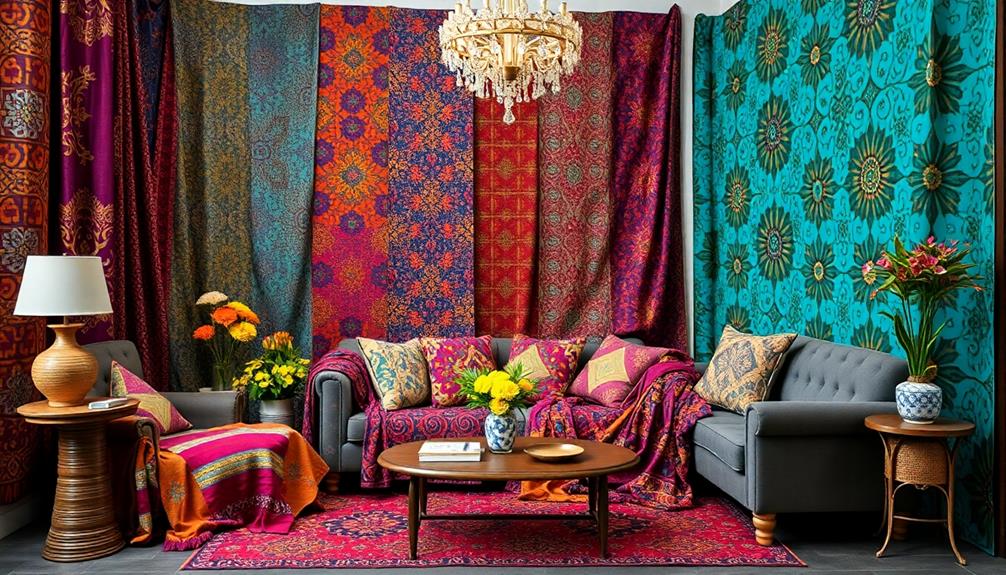
Batik's rich tradition stems from Indonesia, showcasing a unique fabric dyeing technique that combines artistry and craftsmanship. The batik process involves applying wax to fabric, creating intricate patterns through a resist dyeing method.
You'll find that artisans use various types of wax, primarily paraffin and beeswax, to block dye absorption in specific areas, resulting in stunning visual effects. This exceptional technique is similar to the craftsmanship seen in traditional Indonesian decor masks, which also reflect the country's cultural heritage through intricate designs and vibrant colors.
What sets true batik apart is that it features the same color on both sides of the fabric, highlighting the skill involved in its creation. This is a significant distinction from printed fabrics, which lack that depth and craftsmanship.
When you explore the batik-making process, you'll see it can take weeks to finish, as artisans engage in multiple dye baths and carefully remove the wax to reveal the final design.
Tools like the tjanting allow for precise wax application, while brushes can create broader effects.
The History of Batik

Batik's roots trace back over a thousand years in Indonesia, where it emerged as a vibrant expression of cultural identity.
This traditional artistry is deeply intertwined with local customs, much like the vibrant artistry of Indonesian decor masks.
You'll notice how the techniques have evolved, with artisans mastering the art of applying wax to create stunning patterns.
Each design tells a story, reflecting the rich traditions and messages unique to the region.
Cultural Origins of Batik
For over a thousand years, people in Indonesia have been perfecting the art of batik, a traditional fabric dyeing technique that employs wax to create stunning patterns. This intricate craft isn't just a method of textile production; it carries deep cultural significance and reflects the rich heritage of Indonesian communities.
Each region boasts its own unique styles and motifs, often telling stories of local history and identity. Batik is often used in Indonesian Decorative Pillows, adding vibrant colors and intricate patterns that enhance living spaces. Imagine the vibrant scenes that batik can evoke in your home:
- Intricate Designs: Each piece tells a story through its patterns, showcasing the craftsmanship of generations.
- Cultural Heritage: Batik represents a living tradition, connecting you to Indonesia's past and present.
- Unique Decor: Incorporating batik into your space adds an authentic touch that sets your style apart.
In 2009, UNESCO recognized batik as a Masterpiece of the Oral and Intangible Heritage of Humanity, further underscoring its importance.
As you explore batik for your home, you'll discover a beautiful blend of artistry and history that enriches your living space while honoring its traditional roots.
Evolution of Techniques
The rich heritage of batik isn't static; it has transformed over centuries, adapting to cultural shifts and technological advancements. Originating in Indonesia, batik techniques date back to ancient times, showcasing intricate designs created through a resist dyeing process using hot wax.
As you explore a batik project, you'll discover that traditional techniques often involve a tjanting tool, which allows artisans to apply wax precisely, resulting in detailed patterns unique to various regions. Additionally, batik often reflects the cultural narratives and artistry seen in other Indonesian handicrafts, such as Indonesian decor masks, enriching the storytelling aspect of the art form.
Over time, batik has embraced modern materials and dyes. The introduction of synthetic dyes in the 19th century broadened the color palette, enabling artists to create more vibrant and varied designs than the natural dyes used previously.
Despite these advancements, many artisans continue to honor traditional techniques, preserving the artistry and cultural significance of batik.
Today, batik techniques are celebrated globally, inspiring contemporary artists and home decor trends. As you engage with batik, through educational workshops or community efforts, you help keep this beautiful tradition alive while adding a distinct touch to your home's style.
Embrace the evolution of batik and let its rich history elevate your space.
Benefits of Batik for Home Decor
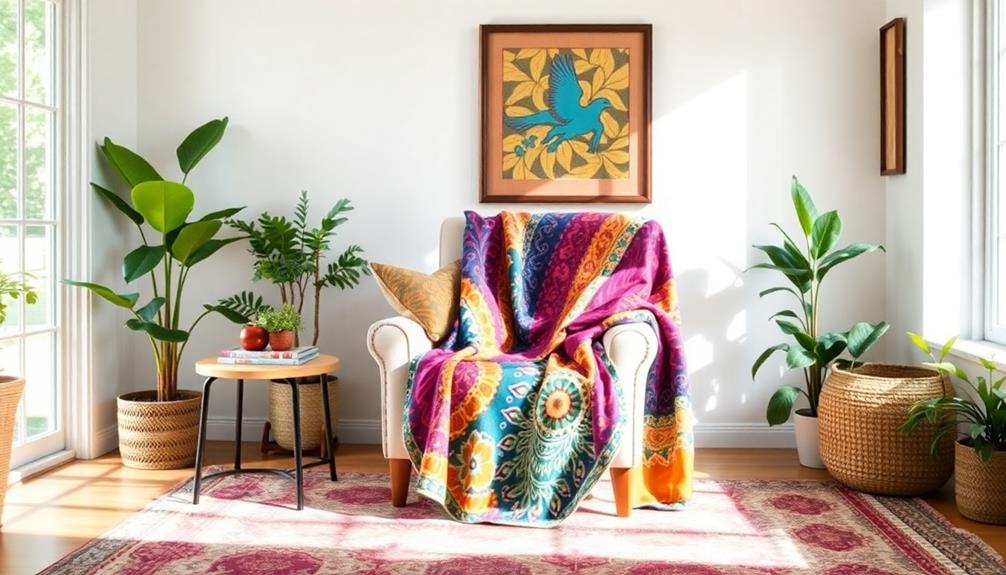
While many home decor options offer style, batik fabric stands out by adding a unique and artistic touch that reflects cultural heritage. By incorporating batik into your home, you not only enhance the aesthetic but also tell a story through intricate designs and craftsmanship.
The vibrant colors and patterns of batik can beautifully complement the natural materials and earth tones found in Balinese interior design concepts, creating a harmonious environment that promotes relaxation and tranquility.
Here are some benefits of using batik in your home decor:
- Vibrant Upholstery: Transform your furniture with batik fabric, bringing colors and textures that complement modern or traditional styles.
- Eye-Catching Wall Hangings: Batik wall hangings serve as focal points in any room, making your space more inviting and personalized.
- Eco-Friendly Choice: Opting for batik, especially those made with natural dyes, aligns with sustainable practices, appealing to environmentally conscious consumers.
Incorporating batik into textiles like cushion covers and table runners enhances your living space's visual appeal, creating a cozy atmosphere.
Batik Techniques and Styles
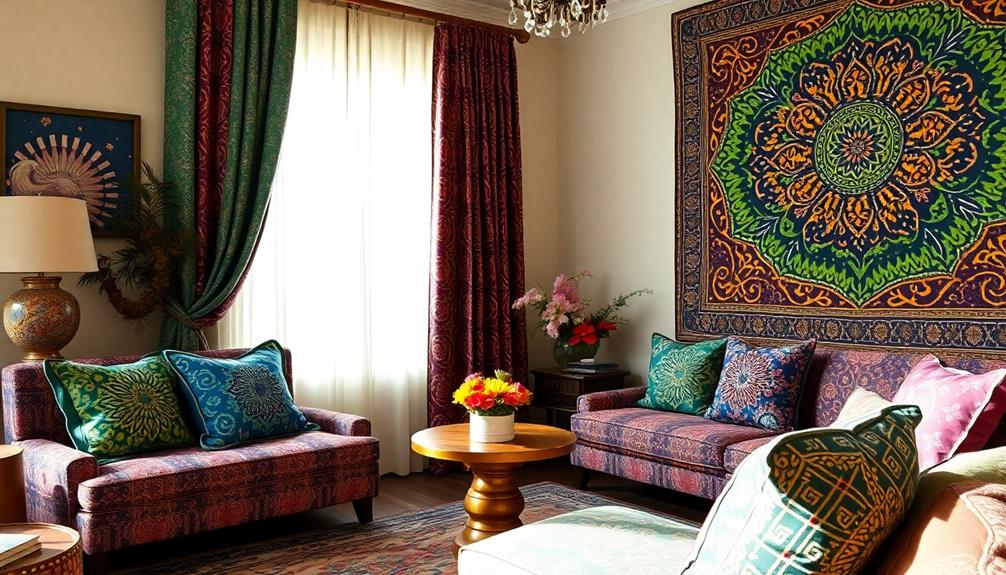
When you explore batik techniques, you'll find a rich blend of traditional methods and modern applications.
Traditional batik relies on wax application and intricate designs, while contemporary styles often embrace innovative uses of this art form.
Incorporating batik into your home decor can beautifully complement luxury tropical designs and create a unique aesthetic.
Understanding these techniques can inspire you to incorporate batik into your home decor in fresh and exciting ways.
Traditional Batik Methods
In traditional batik methods, artisans skillfully apply a resist dyeing technique using wax to create intricate patterns on fabric. This process begins with tracing designs onto the fabric, followed by the careful application of wax using a tjanting tool or brushes. The tjanting's copper cup allows for precise wax application, while brushes enable broader strokes for more extensive designs.
The artistry of batik reflects traditional Indonesian style home decor, showcasing the rich cultural heritage and craftsmanship behind each piece.
Consider these elements of the batik process:
- Dual wax types: Paraffin adds stiffness and crackle effects, while beeswax allows for smoother line work and intricate details.
- Dyeing baths: The dyeing process involves multiple baths, starting with lighter colors and moving to darker shades, creating complex layering and rich color combinations.
- Wax removal: After dyeing, artisans remove the wax by boiling or ironing, ensuring the fabric retains its softness and vibrancy.
Through this meticulous process, you can appreciate the artistry and dedication that goes into creating stunning batik designs, making them a beautiful addition to your home style.
Traditional batik not only showcases elegance but also tells a story through its intricate patterns.
Modern Batik Applications
Modern batik applications have taken off, bringing this traditional art form into contemporary home design. You can find modern batik techniques using a variety of fabrics like cotton, silk, and even synthetic materials, making them perfect for diverse home decor choices.
With pre-mixed batik wax, artists can create intricate designs that pop with vibrant color effects, adding life to your living spaces. The incorporation of batik textiles can also reflect traditional Indonesian housing styles, showcasing the rich cultural heritage inherent in these designs.
Advanced styles often involve multiple dye baths and resist techniques, allowing for stunning layered color combinations. Think about incorporating batik textiles like curtains and cushions that enhance your home's aesthetic. These elements not only beautify your space but also serve as unique focal points that showcase the craftsmanship and cultural significance of batik.
Contemporary batik artists are pushing boundaries, experimenting with non-traditional patterns and innovative color palettes. This versatility means you can find batik pieces that align perfectly with your personal style, whether you prefer bold and vibrant or subtle and understated.
Incorporating Batik Into Your Space
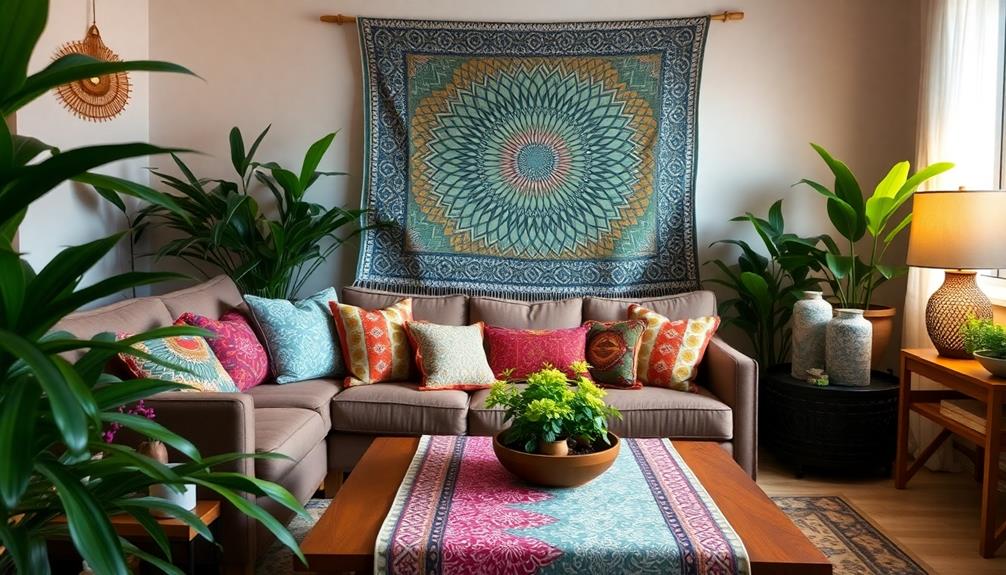
Batik can effortlessly elevate your home's style, turning everyday spaces into vibrant showcases of culture and artistry. By incorporating batik into your home decor, you not only enhance the aesthetics but also promote appreciation for traditional craftsmanship.
The unique designs and vibrant colors of batik fabric can add character and warmth to any room, creating an inviting atmosphere that draws people in. Additionally, batik can harmonize beautifully with tropical villa plans, emphasizing open spaces and natural light.
Consider these ideas for incorporating batik into your space:
- Throw Pillows: Add a pop of color to your sofa with batik-patterned cushions that invite comfort and conversation.
- Table Runners: Dress your dining table with a stunning batik runner, offering a striking contrast to neutral tableware and enhancing the dining experience.
- Wall Hangings: Showcase batik art on your walls, turning them into a gallery that tells stories of heritage and artistry.
With such versatility, batik can seamlessly complement your existing decor style, whether it's modern, minimalist, bohemian, or eclectic.
Embrace the beauty of batik and transform your home into a vibrant haven of unique designs and cultural significance.
Care and Maintenance of Batik Fabrics

To keep your batik fabrics looking their best, it's essential to follow some straightforward care guidelines.
Start by hand washing your batik in cold water with a mild detergent. This helps preserve the intricate designs and vibrant colors. Avoid using bleach or harsh chemicals, as they can severely fade the colors and weaken the fabric over time.
When drying your batik, hang or lay it flat away from direct sunlight. Sunlight can cause the beautiful colors to fade, diminishing the fabric's appeal.
For maintenance, when it's time to iron, use a low to medium heat setting. Always place a cloth between the iron and the fabric to protect the wax-resist areas from direct contact.
Storage is equally important. Keep your batik items in a cool, dry place, preferably wrapped in cotton or acid-free tissue paper. This prevents creasing and protects against moisture and pests.
DIY Batik Projects for Home

After caring for your batik fabrics, why not take your creativity a step further with DIY batik projects? These projects allow you to add unique, vibrant patterns to your home décor, showcasing intricate designs that reflect cultural artistry.
Incorporating traditional motifs and patterns can enhance the cultural significance of your creations. You can use a combination of paraffin and beeswax to create stunning effects, and the results will be one-of-a-kind! With vibrant colors and floral arrangements, your batik decor can truly elevate the ambiance of your space traditional motifs.
Here are a few ideas to get you started:
- Wall hangings: Transform a blank wall into a canvas of color.
- Decorative table runners: Bring life to your dining table with beautiful patterns.
- Cushion covers: Create cohesive aesthetics throughout your living space.
To begin, you'll need to melt the wax and carefully apply it to the fabric before you dye the cloth with Procion dye. The wax removal process, once the dye has set, will reveal your intricate designs.
By layering wax and dye, you can achieve complex color effects that make each piece truly special. Engaging in these projects not only enhances your style but also promotes sustainability by reusing materials creatively.
Batik vs. Other Textile Arts

When you compare batik to other textile arts, the unique design techniques truly stand out.
The meticulous use of wax in batik not only creates intricate patterns but also carries deep cultural significance that many other methods lack.
Understanding these differences can help you appreciate the artistry behind batik and its role in diverse cultures.
Unique Design Techniques
Batik stands out among textile arts due to its intricate and deliberate design techniques that set it apart from methods like screen printing or tie-dye. With batik, you experience a unique artistry that combines precise planning and creativity, resulting in stunning fabric that tells a story.
- Layering Wax: Batik artists skillfully apply layers of wax to create complex patterns and textures, allowing for a rich depth that other techniques can't achieve.
- Dye Techniques: The process involves multiple dye baths, enabling vibrant color combinations that transform fabric into a visual masterpiece.
- Unique Designs: Each piece of batik is one-of-a-kind, thanks to the wax-resist method, which prevents dye from reaching certain areas, resulting in intricate, detailed imagery.
Unlike tie-dye's random patterns, batik offers a structured approach, where the wax acts as a barrier, leading to exceptional detailing.
The use of both paraffin for stiffness and beeswax for flexibility allows artists to manipulate textures, making batik a distinctive form of textile art.
When you incorporate batik into your home, you're not just decorating; you're embracing a rich tradition of unique designs.
Cultural Significance Comparison
Textile arts around the world carry deep cultural significance, and batik is no exception. This traditional Indonesian fabric dyeing technique stands out with its intricate resist designs created using wax, unlike other methods like tie-dye, which simply involves knotting fabric. True batik showcases the same color on both sides, highlighting its craftsmanship and the importance of preserving heritage.
Batik serves as a unique storytelling medium, reflecting historical narratives and local traditions. Each piece tells a story, much like tapestry weaving in various cultures.
While batik has gained global recognition, influencing contemporary textile arts and home decor, it remains rooted in its cultural origins. This contrasts sharply with synthetic and mass-produced textile arts, which often lack depth.
Philosophically, batik embodies a strong connection to community and identity, similar to Japanese shibori and Indian block printing. These textile arts also carry rich cultural meanings, celebrating their respective histories and techniques.
Sources for Quality Batik Fabrics
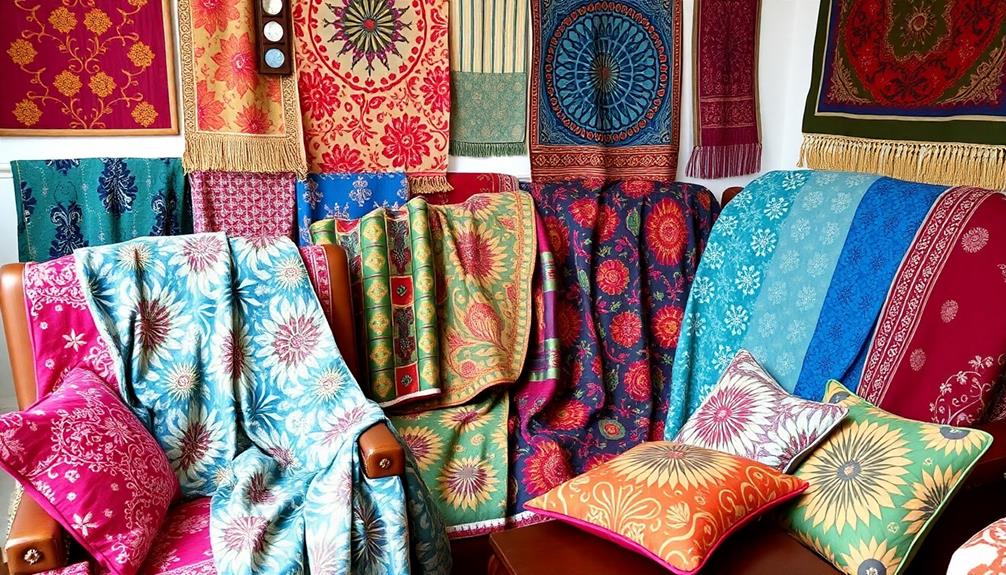
Finding quality batik fabrics can transform your home decor with their vibrant colors and intricate designs. Sourcing these fabrics involves looking for artisans who uphold traditional craftsmanship, particularly from regions like Indonesia.
Here are some tips to help you find the best options:
- Check local artisans: They often create unique pieces that reflect authentic techniques.
- Explore specialized fabric shops: These stores usually carry quality batik and support sustainable practices.
- Browse online platforms: Websites like Etsy showcase a variety of options, allowing you to compare patterns and materials easily.
When selecting your batik fabrics, seek those made with a blend of paraffin and beeswax. This combination enhances dye resistance and allows for detailed patterns.
Pay attention to the weight and texture as well; high-quality batik typically has a soft, pliable feel that drapes beautifully, making it ideal for various home decor applications.
By choosing the right sources, you not only enhance your living space but also support artisans who prioritize quality batik and sustainable practices.
Happy decorating!
Inspiring Batik Decor Ideas
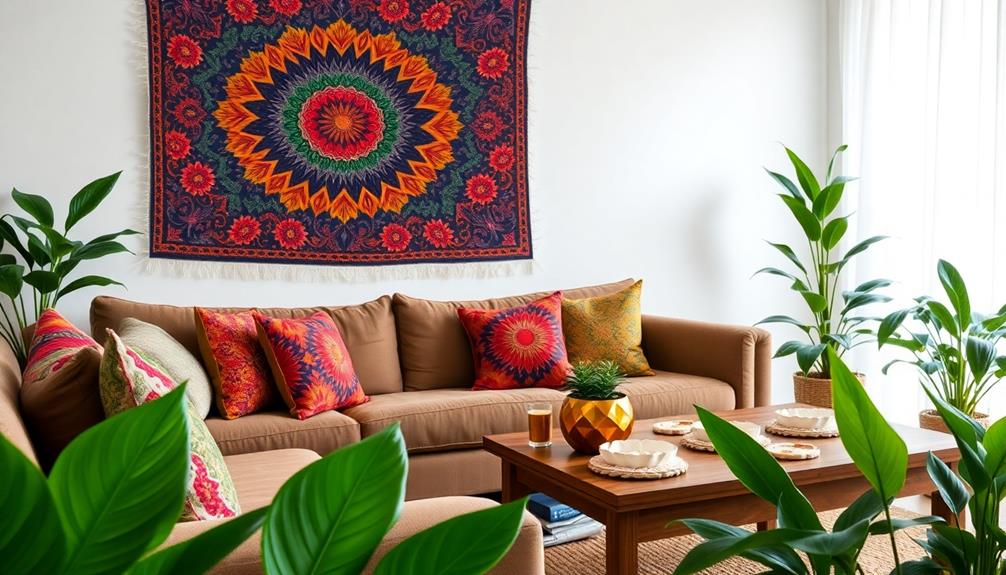
Infusing your home with batik decor can create a vibrant and culturally rich atmosphere that captivates the eye.
Start by incorporating batik wall hangings; their intricate patterns can serve as stunning focal points in any room, reflecting a deep cultural heritage. For a quick update, consider adding batik throw pillows. They provide a pop of color and texture, making it easy to refresh your home decor without a complete redesign.
In your dining area, batik fabric shines as table runners or placemats, creating an inviting atmosphere while showcasing the artistry of batik. Not only do they protect your surfaces, but they also elevate your dining experience.
Batik curtains are another fantastic option. They filter light beautifully, offering a soft, artistic touch to your windows while enhancing the overall ambiance of your space.
Frequently Asked Questions
Why Is Batik Declining?
Batik's decline stems from mass-produced textiles offering cheaper options, automation threatening its uniqueness, and synthetic fabrics gaining popularity. You'll notice fewer artisans passing down traditional skills, risking the cultural heritage that batik represents.
Does Batik Have a Wrong Side?
Batik doesn't really have a wrong side. Both sides showcase the intricate designs and colors from the wax-resist dyeing process. This unique feature makes every piece a work of art, rich in cultural significance.
Is Batik Bad for the Environment?
Did you know that traditional batik can produce up to 7,000 liters of wastewater per batch? While batik can harm the environment, many artisans are now adopting eco-friendly practices to reduce their impact.
What Are the 4 Different Ways Batik Can Be Done?
You can explore batik through four main techniques: wax resist, where wax blocks dye; direct application for vibrant designs; tie-dye batik for unique patterns; and crayon batik, perfect for beginners and fun projects.
Conclusion
So, you might think batik is just a fancy fabric, but it's actually a game-changer for your home's vibe. Who knew that a bit of dye and wax could transform your space from drab to fab? Whether you drape it over furniture or hang it as art, batik brings a splash of culture and creativity. So go ahead, embrace the unexpected—your walls will thank you, and you'll be the trendsetter everyone can't help but admire!
Home Decor
Batik Patterns That Will Instantly Upgrade Your Interior Design Game
Immerse yourself in the vibrant world of batik patterns that can transform your space—discover how these designs can elevate your interior design today!
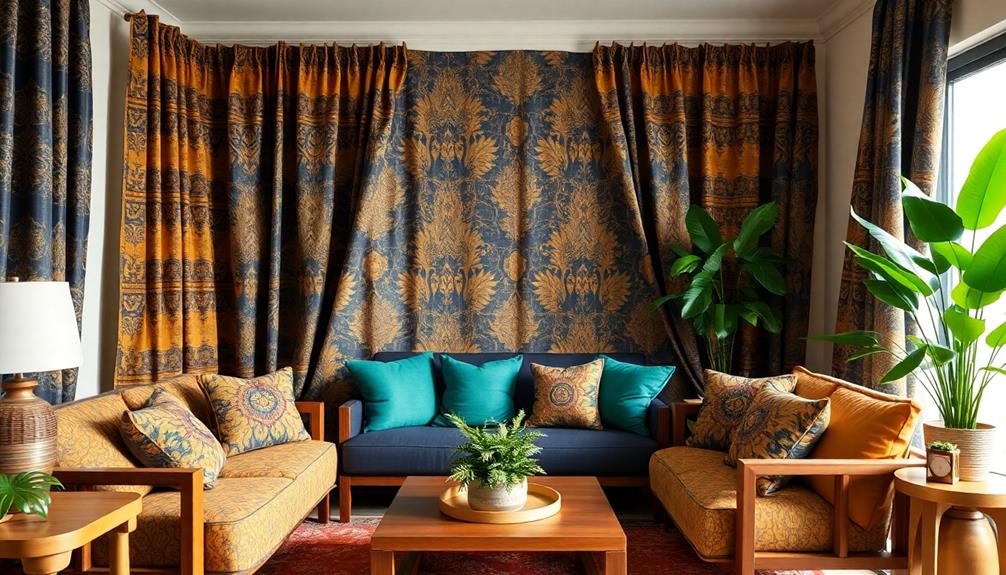
Batik patterns can instantly elevate your interior design game with their vibrant colors and intricate motifs. By incorporating textiles like throw pillows and curtains, you'll add depth and cultural significance to your space. Consider using symbolic designs, like the Parang or Pucuk Rebung, for a more meaningful touch. They also work beautifully as wall art or in mixed-pattern gallery walls. Don't forget about their durability, making them perfect for high-traffic areas. With the right colors and styles, you can create inviting atmospheres. Explore various batik applications to discover how they can enhance your home's aesthetic.
Key Takeaways
- Batik patterns offer rich cultural significance and history, enhancing the storytelling aspect of your interior decor.
- Incorporate batik textiles like throw pillows and curtains to add vibrant colors and unique designs to any room.
- Use framed batik pieces or large prints as eye-catching wall art to create focal points in your space.
- Mix and match batik patterns with solid colors for visual depth and to elevate your overall aesthetic.
- Explore DIY batik projects, such as custom pillow covers, to infuse personal style and creativity into your decor.
Understanding Batik Patterns
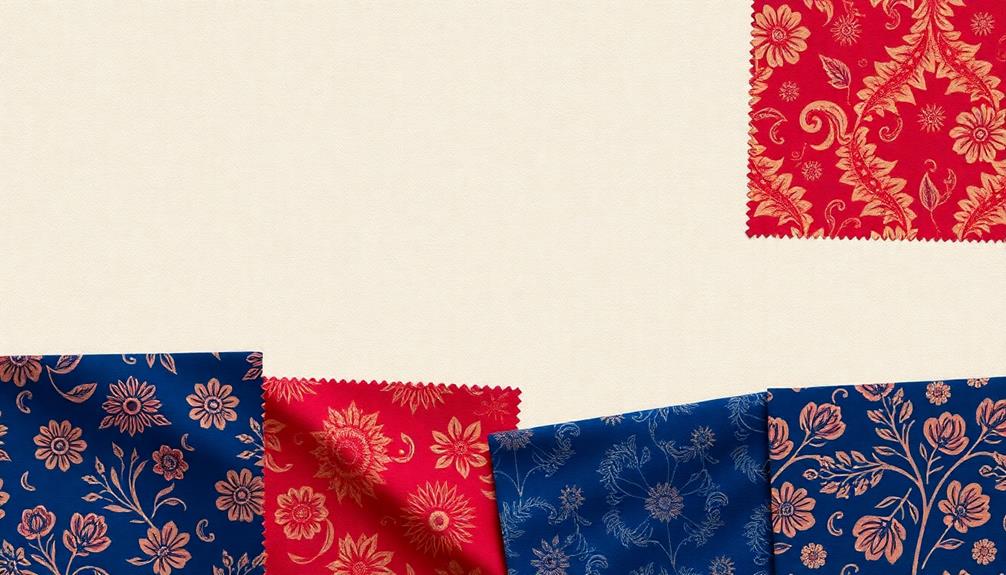
Batik patterns are an extraordinary blend of artistry and cultural significance that you can easily appreciate. These intricate designs, rooted in Indonesian batik, are created using a wax resist dyeing technique that allows for vibrant colors and detailed motifs. Each pattern embodies specific meanings; for instance, the Pucuk Rebung represents a divine connection, while the Bledak background stands for happiness and the purity of the soul.
Additionally, exploring traditional artistry in decor masks can further enrich your understanding of Indonesia's cultural heritage.
The art of batik dates back to the 9th century, with Indonesian artisans establishing techniques that continue to influence contemporary designs. You'll find that coastal batik patterns often reflect cultural exchanges, showcasing elements from Chinese, European, and Middle Eastern aesthetics, resulting in unique visual expressions.
Modern designers like Didiet Maulana are revitalizing traditional motifs, blending them with sustainable practices. This emphasizes the ongoing relevance of batik in today's design landscape.
Understanding these batik patterns allows you to appreciate not just their beauty but also the rich cultural narratives they tell. Integrating them into your interior design can elevate your space, making it both visually stunning and culturally meaningful.
Popular Batik Styles
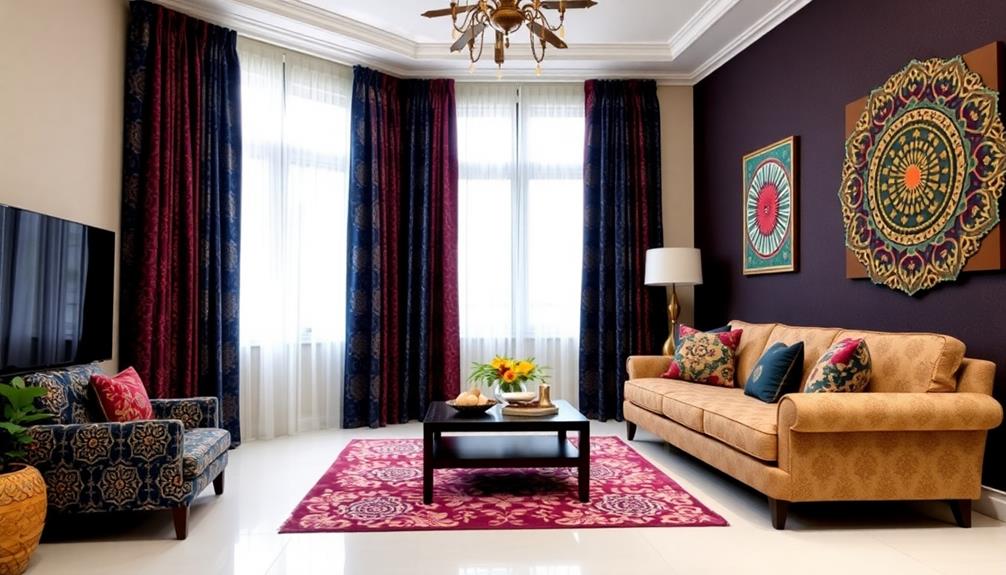
Throughout history, various batik styles have emerged, each with unique characteristics and meanings. One of the most popular is the intricate Parang design, symbolizing the endless struggle of life. It's a great choice if you want to convey depth in your decor, especially when paired with Indonesian Decorative Pillows that enhance living spaces.
Another enchanting style is the geometric Truntum pattern, known for its vibrant colors and unique shapes. This batik design can add a lively touch to any room.
Coastal batik, especially from Lasem and Cirebon, showcases a blend of Chinese and European influences, resulting in distinct patterns that break away from traditional inland designs. If you're looking for something that symbolizes growth, consider the Pucuk Rebung motif, representing bamboo sprout tips. This design emphasizes connection to the divine and nature.
Modern batik designs often reinterpret ancient styles by blending traditional aesthetics with contemporary elements, making them appealing to today's consumers. They also focus on sustainability, which is a bonus for eco-conscious decorators.
Each of these popular batik styles tells a story, reflecting deep cultural meanings and emotions tied to Indonesian heritage, making them perfect for elevating your interior design game.
Incorporating Batik in Home Decor
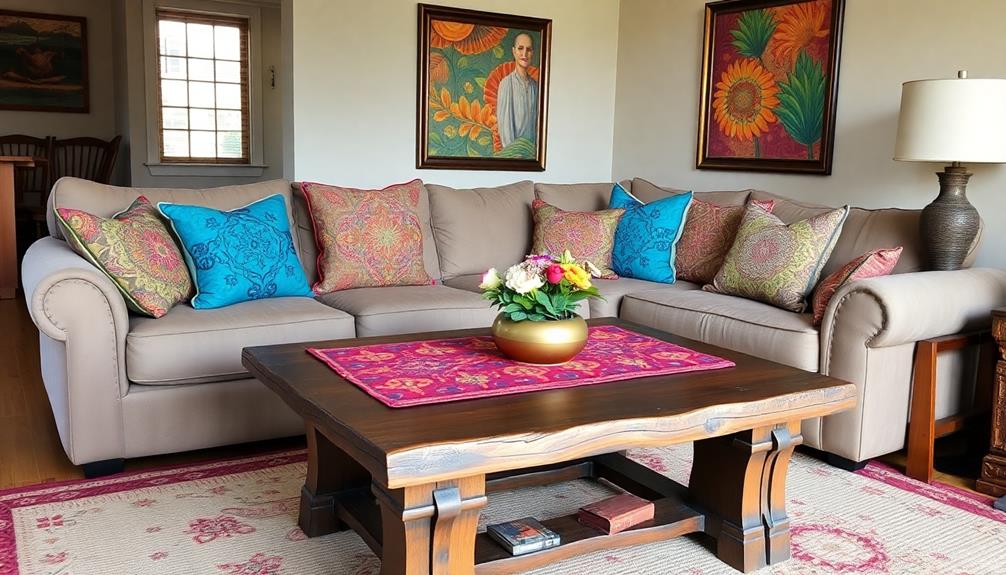
If you're looking to infuse your home with vibrant colors and rich cultural heritage, incorporating batik patterns into your decor is a fantastic way to do so. These intricate designs are perfect for adding a unique touch to your space, much like the stunning craftsmanship found in Indonesian decor masks.
You can start by using batik textiles like throw pillows or table runners, which easily update existing decor while showcasing the craftsmanship of Indonesian culture.
Batik's versatility allows it to fit seamlessly into various interior styles, whether you lean towards modern, bohemian, or something in between. Consider using batik in curtains or drapes to create an eye-catching focal point that enhances natural light and highlights the detailed patterns that tell a story.
You might even think about framing batik pieces as wall art, transforming them into striking statement pieces that spark conversation.
As batik gains popularity in contemporary design, using these patterns not only elevates your home's aesthetics but also connects your space to a broader cultural narrative. Embrace the beauty of batik and watch your interior design game soar!
Batik Textiles for Upholstery
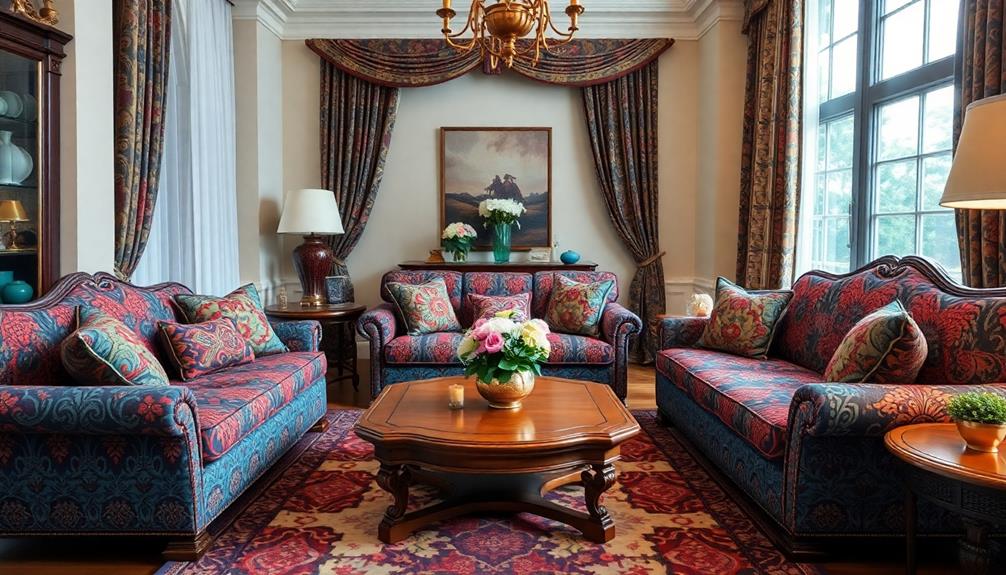
When you want to make your furniture pop, consider using batik textiles for upholstery. Batik cloth, known for its vibrant colors and intricate seamless patterns, can elevate your furniture and enhance your interior design.
These fabrics not only add a unique cultural element but also create a stunning focal point that draws the eye. Incorporating batik textiles can align beautifully with traditional Indonesian style home decor, emphasizing harmony with nature and creating a relaxed atmosphere.
Here are three reasons to choose batik textiles for your upholstery project:
- Durability: 100% cotton batik fabrics are resilient and can withstand everyday wear and tear, making them ideal for high-traffic areas.
- Versatility: With designs ranging from traditional motifs to modern interpretations, you can easily find a batik textile that complements your existing decor style, whether it's bohemian, contemporary, or something in between.
- Emotional Connection: Batik patterns tell stories and evoke emotions, enriching the overall aesthetic of your space.
Wall Art Ideas Using Batik

After enhancing your furniture with batik textiles, it's time to contemplate how these vibrant patterns can also elevate your wall decor. Incorporating batik wall art can add beautiful colors and intricate designs to any room, making it visually stunning.
You can frame batik fabric and hang it as artwork, showcasing unique motifs that serve as a cultural focal point in your space. Additionally, exploring the importance of Indonesian decor masks can further enrich your understanding of cultural artistry and its impact on home decor.
Consider using large-scale batik prints as wallpaper or wall hangings. This approach creates a dramatic effect, transforming an entire area with rich textures and colors. For a personalized touch, custom canvas prints featuring your favorite batik motifs allow you to reflect your unique style.
Mixing and matching different batik patterns can create a dynamic gallery wall, giving your interior design a sense of movement and diversity. By choosing seamless patterns, you can maintain a cohesive look while exploring various designs.
Whether you go for framed pieces or bold wallpaper, batik wall art will certainly enhance your home's aesthetic, making it both inviting and stylish. So, embrace the beauty of batik and let your walls tell a story of culture and creativity!
DIY Batik Projects

DIY batik projects offer a fantastic way to infuse your home with unique, vibrant decor that aligns beautifully with the principles of Balinese design characteristics.
With these projects, you can create stunning items that reflect your personal style while showcasing beautiful patterns and colors. Here are three ideas to get you started:
- Pillow Covers: Transform your living room with custom batik pillow covers that add a pop of color and personality.
- Table Runners: Create eye-catching table runners that serve as functional art during gatherings and celebrations.
- Wall Art: Use batik patterns to craft framed pieces that tell a story and enhance the character of your space.
For beginners, the Klutz Design & Dye with No-Heat Batik Activity Kit is a perfect choice. It provides all the materials and instructions you need to start crafting without the mess of traditional dyeing.
Experimenting with various batik patterns and color combinations will lead to stunning, one-of-a-kind creations. Additionally, you can utilize batik digital paper for versatile applications, such as custom wallpaper or greeting cards.
Immerse yourself in these DIY batik projects, and watch your interior design game soar!
Choosing the Right Colors

Choosing the right colors in batik patterns can dramatically transform your interior space, creating a vibrant and inviting atmosphere. High-quality batik fabrics often feature rich, saturated hues, enhancing any room's design.
Furthermore, blending these textiles with elements from expert tropical design can elevate the overall aesthetic. Start by selecting complementary colors from your chosen batik pattern. Pair warm tones with cooler shades to introduce balance and harmony.
Incorporate a focal batik piece, like a pillow or wall hanging, in a striking color to anchor your design. This not only draws attention to the unique patterns typical of batik textiles but also adds a point of interest.
To maintain visual appeal, mix batik patterns with solid colors that echo hues from the batik. This guarantees a fluid shift between decor elements.
Don't shy away from combining large, bold batik prints with smaller, intricate designs. This mix provides depth and complexity, making your overall interior design more engaging and dynamic.
Batik Patterns for Different Spaces
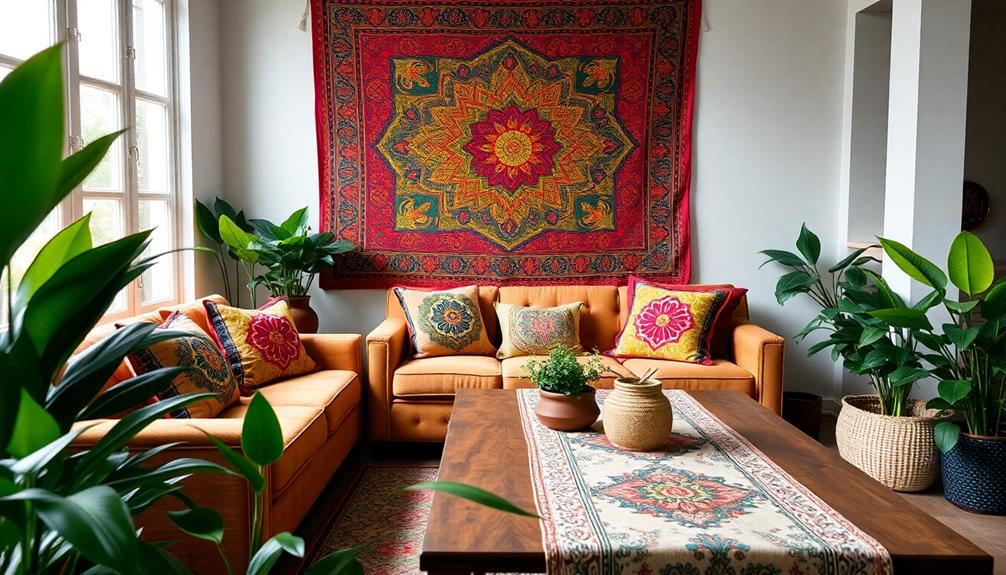
When you add batik patterns to your living room, bold prints on throw pillows or curtains can instantly energize the space.
In the bedroom, choosing batik bed covers or accent quilts brings a cozy yet stylish vibe, showcasing your unique taste.
Let's explore how these patterns can elevate different areas of your home.
Living Room Accents
Incorporating batik patterns into your living room can transform the space into a vibrant and inviting haven. These unique designs add color and texture, making your home feel warm and welcoming. You can enhance your decor by blending traditional batik elements with modern aesthetics for a truly unique look.
Consider exploring Indonesian wedding decor ideas for inspiration on incorporating intricate designs. Here are some ways to elevate your living room with batik:
- Batik-patterned throw pillows: They're an easy way to infuse color and comfort, creating a cozy atmosphere.
- Batik table runners or placemats: These items not only enhance your coffee table decor but also showcase artistic expression in your daily life.
- Framed batik textiles: Use them as wall art to highlight intricate designs and craftsmanship, serving as unique focal points that draw attention.
Consider using natural dyes when selecting batik fabrics, as they not only provide a rich aesthetic but also promote sustainability.
You can even reupholster furniture like chairs or ottomans to create bold statement pieces that reflect cultural heritage. Adding batik-patterned curtains will bring a lively aesthetic while allowing natural light to filter beautifully through your living space.
Embrace the charm of batik and watch your living room transform!
Bedroom Textiles Choices
Batik patterns can breathe life into your bedroom textiles, offering a vibrant touch that enhances your personal style. By incorporating striking batik designs into your duvet covers or throw pillows, you create a focal point that elevates the overall aesthetic of your space.
Known for their intricate designs and rich colors, batik fabrics allow you to express your unique style and celebrate cultural heritage. To further enhance your bedroom's atmosphere, consider blending these patterns with tropical villa plans that emphasize open spaces and natural light.
When selecting batik patterns, consider calming colors for bedding and curtains to promote a serene atmosphere, ideal for relaxation. Whether you're going for a bohemian vibe or a modern look, the versatility of batik designs makes it easy to mix and match textiles with complementary colors.
Not only do batik patterns add visual interest, but they also support sustainable and ethical fashion by celebrating traditional craftsmanship.
Sources for Batik Products
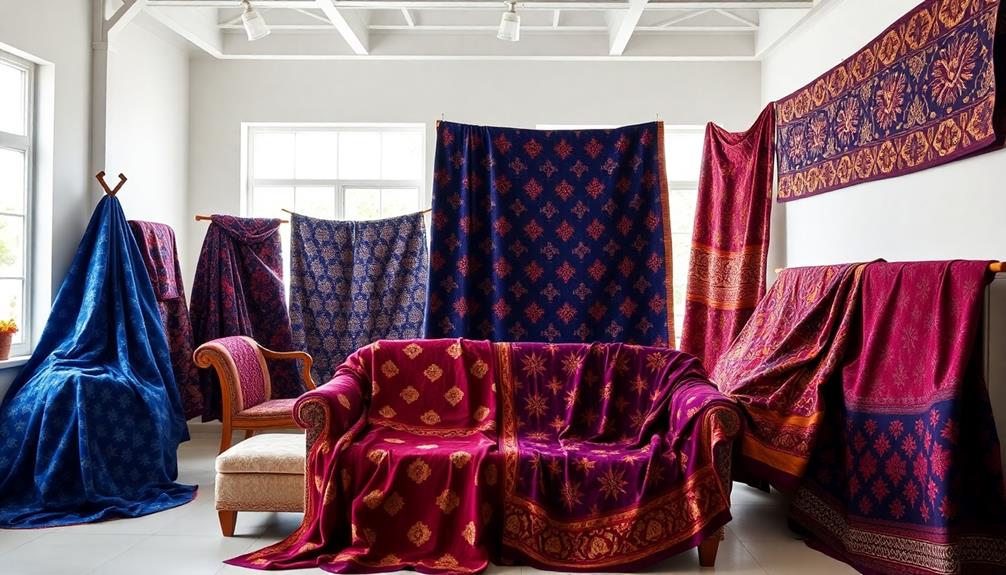
For anyone looking to enhance their interior design with stunning batik products, a variety of options are available at different price points. The rich history of traditional Indonesian housing often showcases intricate batik designs, making these products not just decorative but also culturally significant.
Whether you're a digital designer or someone who loves traditional craftsmanship, there's something for everyone.
Here are some great sources for batik products:
- Traditional Batik Digital Paper: Priced at €3.57, these versatile options are perfect for all your design projects.
- Batik Pattern Texture Brushes for Procreate: At €5.35, this set of 100+ brushes is a fantastic way to incorporate batik elements into your digital artwork.
- Handmade Batik Green and White Fabric: For €44.32, you can add unique designs to your upholstery or decorative accents.
If you're into vibrant designs, consider the Rainbow Batik Digital Seamless Patterns for just €3.07.
For those interested in traditional crafts, a Vintage Batik Stamp from Indonesia can be yours for €158.39. These unique pieces can add a distinctive touch to your home decor, showcasing the beauty of the wax resist technique found in batik patterns.
Explore these sources and elevate your interior design game!
Frequently Asked Questions
What Is the Most Famous Batik Pattern?
The most famous batik pattern is "Parang." It symbolizes the never-ending struggle against evil, characterized by diagonal lines and wave-like motifs. You'll appreciate its deep cultural significance and striking design in any setting.
What Are the 5 Major Types of Batik Design?
Imagine draping your living room in Ceplok batik, its geometric shapes adding a modern touch. The five major types include Parang, Kawung, Ceplok, Lereng, and Tumpal—each with unique meanings and aesthetic appeal.
How to Make Your Own Batik Design?
To create your own batik design, start with quality cotton fabric, apply melted wax to form patterns, dye with chosen colors, and then remove the wax to reveal stunning, vibrant designs that reflect your creativity.
What Are the Patterns of Batik?
Did you know that UNESCO recognized batik as a Masterpiece of the Oral and Intangible Heritage of Humanity? Batik patterns include floral motifs, geometric designs, and symbolic representations, each telling unique cultural stories.
Conclusion
So, as you explore batik patterns for your home, you might just find that perfect piece that sparks joy and conversation. Imagine a vibrant batik cushion on your sofa, or a stunning wall hanging that ties the room together. It's funny how a simple pattern can transform your space and mood. Don't wait—dive into the world of batik and watch your interior design game soar. You never know, your next favorite decor might be just around the corner!
Home Decor
7 Ways to Add Indonesian Textile Magic to Your Modern Home
Find out how to infuse your modern home with vibrant Indonesian textiles for a unique touch that will leave guests in awe.

You can easily add Indonesian textile magic to your modern home in several creative ways. Start by embracing vibrant Batik patterns in cushions or table runners to inject color and culture into your decor. Reupholster furniture with Batik fabrics for a revitalizing twist. Use Batik wall art as striking focal points. Create unique table settings with Batik napkins and placemats, and incorporate handmade Batik accessories like curtains and cushion covers. Utilize natural fabrics for a sustainable touch. Layer your textiles to enhance texture and warmth, enriching your space. There's so much more to explore that can elevate your home's ambiance.
Key Takeaways
- Incorporate vibrant Batik patterns in cushion covers and table runners to enhance your living and dining spaces with cultural flair.
- Reupholster furniture with Batik textiles for a unique character that blends modern aesthetics with traditional craftsmanship.
- Use Batik wall art to create striking focal points that showcase the intricate beauty of Indonesian design.
- Design cohesive table settings with Batik napkins and placemats, adding elegance and a touch of vibrancy to dining experiences.
- Integrate natural fabrics like cotton and bamboo alongside Batik textiles for sustainable comfort and a warm atmosphere in your home.
Embrace Batik Patterns

When you embrace Batik patterns, you're inviting a piece of Indonesia's rich cultural heritage into your home. These intricate designs, created through a unique wax-resist dyeing technique, bring a striking visual appeal that elevates your home decor. The vibrant artistry of Batik reflects the rich traditions of Indonesia, allowing you to celebrate cultural heritage through your decor traditional artistry.
Whether you opt for vibrant cushion covers or pillow accents, mixing and matching Batik fabrics instantly adds cultural flair to your living space.
Incorporating Batik table runners and napkins can transform your dining experiences, especially during festive occasions. They infuse your meals with the artistry and heritage of Indonesian textiles, impressing your guests while showcasing your taste.
If you're feeling creative, consider crafting DIY Batik wall art. You can use fabric or canvas to create eco-friendly pieces that serve as stunning statement art when framed and displayed.
Batik patterns also shine in everyday accessories like wall hangings, curtains, and lampshades. By using these textiles, you personalize your decor while reflecting the beauty of Indonesian craftsmanship.
Add Textiles to Furniture
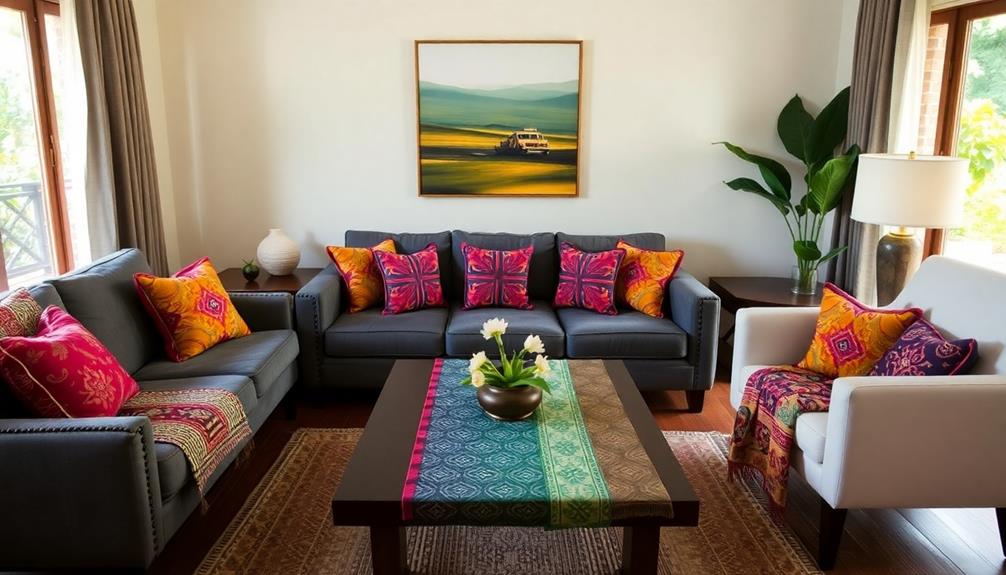
How can you elevate your furniture with the vibrant essence of Indonesian textiles? By incorporating Batik fabric, you can transform your living spaces into a stunning showcase of cultural artistry. Consider reupholstering chairs or ottomans with bold Batik patterns, instantly adding character and flair to your interior design.
You can also enhance your sofas and beds with Batik cushions and pillows, mixing various designs for a dynamic look. A Batik-covered headboard can turn your bedroom into a focal point, reflecting rich heritage and craftsmanship.
To elevate your dining experience, use Batik slipcovers or cushions on dining chairs. They provide comfort while adding colorful designs that spark conversation.
Here's a quick overview of how to incorporate Batik textiles into your furniture:
| Furniture Piece | Batik Application |
|---|---|
| Chairs | Upholster with vibrant Batik fabric. |
| Sofas | Add cushions with mixed patterns. |
| Beds | Create a Batik-covered headboard. |
| Dining Chairs | Use slipcovers or cushions. |
| Vintage Furniture | Reupholster for a contemporary look. |
Embrace the beauty of Indonesian textiles and let your furniture become a statement of art!
Decorate With Batik Wall Art

Batik wall art is an enchanting way to infuse your home with the rich colors and patterns of Indonesian culture. These pieces not only showcase the artistry of Batik but also represent a deep cultural heritage, making them a perfect addition for those who appreciate unique artistic expressions.
You can choose to create these stunning pieces using fabric or canvas, allowing for versatile designs that reflect your personal style and cultural heritage. The traditional wax-resist technique, where wax is applied to fabric before dyeing, results in intricate patterns that showcase the artistry of Batik.
Opting for natural dyes in your batik wall art not only promotes eco-friendliness but also offers unique color variations that enhance each artwork's charm. When you finish your Batik pieces, consider framing them to elevate their appearance, transforming them into striking focal points in your modern home decor.
Hanging batik wall art in your living spaces adds vibrant colors and culturally rich patterns, enriching the ambiance and celebrating Indonesian textile traditions.
Whether you prefer bold designs or subtle hues, these artworks can create a stunning visual impact while connecting you to a rich cultural legacy. So, don't hesitate—bring the beauty of batik into your home and let it inspire conversations and admiration.
Create Unique Table Settings

Transforming your dining experience can be as simple as incorporating Batik into your table settings. Start by adding a Batik table runner to introduce vibrant patterns and cultural flair that enhance both casual and formal meals. The rich colors and intricate designs of Batik not only elevate the aesthetic but also celebrate Indonesian textile craftsmanship.
Pair this with Batik napkins, which not only complement your dinnerware but also add a touch of elegance and uniqueness to your arrangements. To protect your surfaces while showcasing intricate designs, create coasters from Batik fabric squares. These decor pieces highlight Indonesian artistry, making them functional and visually appealing.
You can also design placemats featuring Batik motifs to provide visual interest and create a cohesive theme, ensuring every meal feels special. Don't be afraid to experiment with layering different Batik prints in your table settings. This approach creates a rich tapestry of colors and textures, celebrating the beauty of this traditional textile art.
Incorporate Batik Accessories

Adding Batik accessories to your home can instantly elevate your decor while showcasing Indonesia's rich textile heritage.
These vibrant patterns not only enhance your living room but also tell a story of traditional craftsmanship, much like the intricate designs found in Indonesian decor masks that depict local myths and folklore.
Here are three ways to incorporate Batik into your space:
- Batik Wall Hangings: Transform Batik fabric into unique wall art. These colorful pieces can serve as a stunning focal point in your living room, adding depth and culture to your decor.
- Handmade Batik Curtains: Opt for Batik curtains that allow natural light to filter through while introducing a pop of color and texture. They'll brighten up your living space while maintaining a warm ambiance.
- Batik Cushion Covers: Refresh your living room with cushion covers or throw pillows adorned with Batik patterns. This small change can make a significant impact, merging comfort with the beauty of Indonesian artistry.
Use Natural Fabrics and Materials
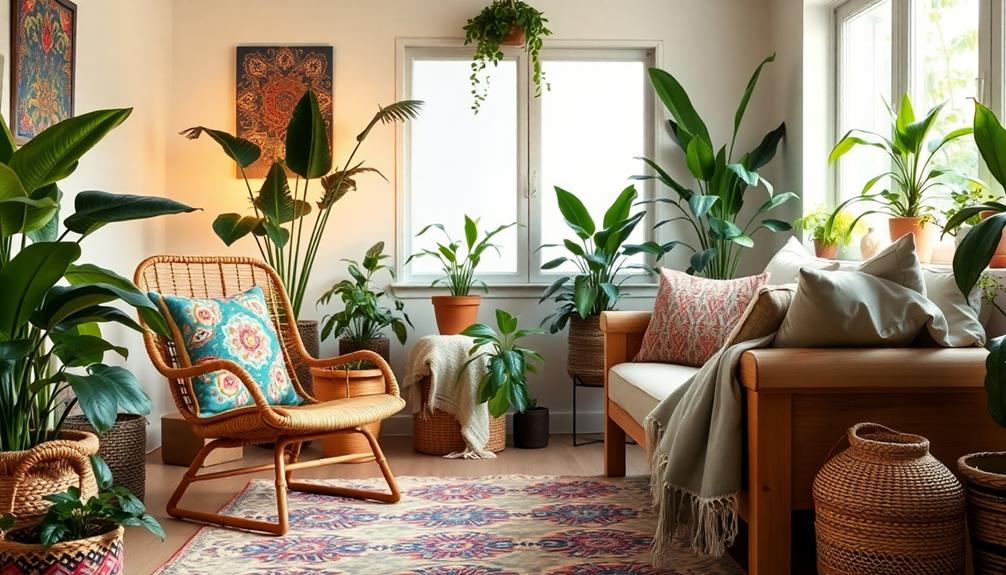
To create a warm and inviting atmosphere in your home, using natural fabrics and materials is key. Incorporating textiles made from cotton, linen, and silk not only enhances breathability and comfort but also showcases the stunning artistry of Indonesian batik patterns. You can elevate your space further by opting for sustainable materials like bamboo and rattan in your furniture and decor. These choices reflect eco-friendly principles while infusing a rustic charm characteristic of Indonesian design.
Here's a quick guide to help you choose the right natural materials:
| Material | Benefits | Usage |
|---|---|---|
| Cotton | Breathable, soft | Curtains, cushions, bedding |
| Bamboo | Sustainable, lightweight | Furniture, decor |
| Teakwood | Durable, elegant | Furniture |
| Linen | Cool, natural texture | Table linens |
| Batik Fabric | Cultural heritage, unique designs | Lampshades, decorative accents |
Selecting textiles with traditional Indonesian motifs adds personality to your space while allowing natural light to filter through beautifully. Embrace these materials to create a harmonious, modern environment that celebrates both comfort and craftsmanship.
Layer With Vibrant Colors
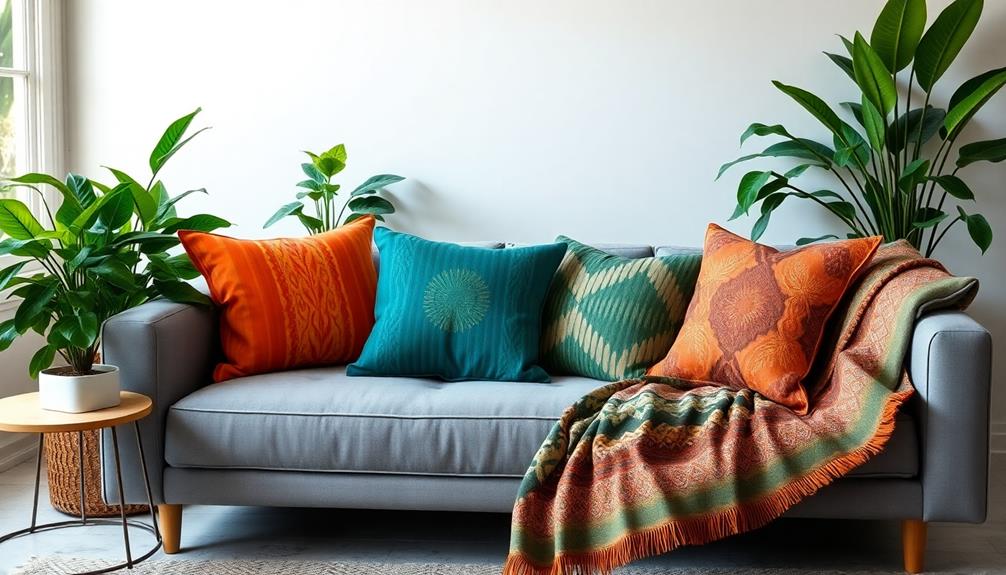
There's something magical about layering vibrant colors in your home, especially when it comes to incorporating Indonesian Batik textiles. The artisans of Bali have mastered the art of creating stunning fabrics in lush emerald greens and deep ocean blues, reminiscent of Indonesia's beautiful landscapes.
To bring that magic into your space, consider the following: The use of natural materials and open spaces can enhance the overall impact of vibrant textiles within your home, creating a harmonious balance.
Balinese design characteristics further emphasize the importance of integrating cultural elements, which makes your decor even more meaningful.
- Throw Pillows: Use various Batik patterns for your cushions to infuse lively energy into your living room. Mix and match different designs to showcase the rich diversity of this traditional art form.
- Wall Hangings: Create a striking focal point with a large Batik wall hanging. The intricate designs can serve as a conversation starter and add vibrant character to your modern interiors.
- Table Linens: Elevate your dining experience with Batik table runners and napkins during gatherings. This not only adds color but also cultural significance, making your meals feel special.
Frequently Asked Questions
Where Can I Buy Authentic Indonesian Textiles Online?
You can buy authentic Indonesian textiles online at various websites like Etsy, Amazon, or specialized shops like IndonesianArtisan. Make certain to check reviews and ratings to guarantee authenticity and quality before making a purchase.
How Do I Care for Batik Fabrics?
Caring for batik fabrics is a delightful journey! Hand wash them in cold water, avoid harsh detergents, and let them air dry. You'll be preserving their beauty while keeping them in prime condition for years.
Can I Mix Batik With Other Fabric Patterns?
Absolutely, you can mix batik with other fabric patterns! Just guarantee the colors complement each other. Combine different textures and styles to create a vibrant look, but maintain a cohesive theme to avoid overwhelming the space.
What Are the Cultural Meanings Behind Specific Batik Designs?
Batik designs carry deep cultural meanings, reflecting stories, nature, and spirituality. Each pattern symbolizes specific values or beliefs. When you explore these designs, you connect with Indonesia's rich heritage and gain a deeper appreciation for its artistry.
Are There Eco-Friendly Options for Indonesian Textiles?
Did you know that over 40% of Indonesian textiles are now made from sustainable materials? You can find eco-friendly options like organic cotton and natural dyes, ensuring your choices support both the environment and local artisans.
Conclusion
Incorporating Indonesian textiles into your modern home creates a stunning contrast between tradition and contemporary style. By blending vibrant batik patterns with sleek furniture, you bring warmth and history to minimalist spaces. The richness of natural fabrics enhances the clean lines of modern design, while colorful accessories breathe life into neutral palettes. Embrace this delightful juxtaposition, and watch how your home transforms into a unique sanctuary that celebrates both heritage and modernity, creating a space that feels both timeless and fresh.
-

 Mom3 months ago
Mom3 months agoHeartfelt Poems for Your Daughter’s Birthday
-

 Mom3 months ago
Mom3 months agoHappy Birthday Religious Wishes and Blessings
-

 Mom3 months ago
Mom3 months agoHappy 65th Birthday: Celebrate Your Special Day!
-

 Mom3 months ago
Mom3 months agoHappy Birthday in Heaven from Daughter: Remembering You
-

 Mom3 months ago
Mom3 months agoCelebrating 60 Years: Happy 60th Birthday Wishes
-

 Mom3 months ago
Mom3 months ago62nd Birthday Quotes for Mom: Celebrate Her Special Day
-

 Mom3 months ago
Mom3 months agoCelebrate a Joyous Happy 70th Birthday Milestone!
-

 Mom3 months ago
Mom3 months agoHappy 61st Birthday: Celebrate This Special Milestone

















